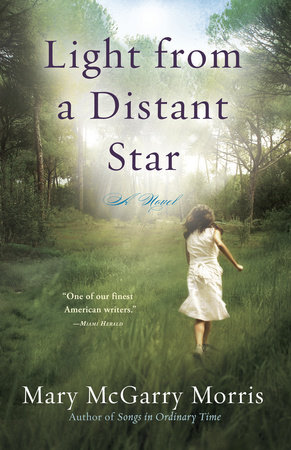Light from a Distant Star Reader’s Guide
By Mary McGarry Morris


1. Tolstoy’s first words in Anna Karenina are: “Happy families are all alike. Every unhappy family is unhappy in its own way.” Do you think the Pecks have been a happy family? Like so many families enduring the strains of teenage rebellion and financial problems are they beginning to come undone?
2. Nellie is at a point in her life when she is in need of heroes. Until her thirteenth summer, Benjamin Peck, Nellie’s principled and upstanding father, has been her hero. What is it about Max Devaney, a brooding loner, an ex-con, that attracts Nellie when he seems to be the complete opposite of her father?
3. Why is Nellie so often drawn to edgy, offbeat people: Jessica Cooper, Bucky Saltonstall, Max Devaney, Dolly Bedelia, the Shelby twins Roy and Rodney, as well as her caustic grandfather?
4. What purpose does the hand-to-hand combat manual from World War II, “Get Tough” serve in Nellie’s quest for courage and strength? Does it give her enough confidence to confront the truth around her?
5. Is there any connection between Ruth Peck’s search for her “real” father and her sister Nellie’s ironically similar quest?
6. The Washington Independent Book Review writes, “Boone is Nellie’s doppelganger in animal form.” How is this apparent in the novel?
7. Nellie’s grandfather’s junkyard, both eyesore and environmental hazard, sits right in the heart of Springvale. “It’s Charlie’s now,” locals say of anything broken-down, unwanted, unfixable. Is Max veritable human trash, also unwanted, shunned, discarded? Was his youthful conviction fair?
8. Sandy Peck regrets renting the back apartment to irresponsible and sexy Dolly Bedelia. How is her unsavory tenant, like Max, another reminder of her embarrassing childhood?
9. In what ways is Nellie very much her father’s daughter, an idealist, a romanticist? If Nellie is still an innocent, can the same be said of her father?
10. Sandy Peck loves her husband, admires his intellect and tries to be loyal, especially in the children’s presence. Is her growing impatience with Benjamin justified? And how does it affect their children? Would it help or make things worse if she were more forceful and outspoken? Should parents openly discuss financial problems with their children?
11. Why does Nellie consider her relationship with her mother so much more complicated than her relationship with her father? Is one parent more honest with her than the other? Or are her confusing feelings often typical of the mother-daughter dynamic?
12. Ruth is far more aware of Benjamin’s failings than Nellie. Are family troubles the catalyst for Ruth’s determination to contact her birth father? Or is that need, that identity crisis a natural stage in the life of an adoptee?
13. What is the significance of Tenley Humboldt’s statement that when he was bullied and humiliated as a child Benjamin stood by and did nothing?
14. Upon seeing Lazlo’s painting of the children’s tree house, Nellie thinks: “It looked like their tree house, but it didn’t. His was a nest of boards and sticks, without nails or bolts, more image than structure. More hope than reality. An idea that with the first strong wind would come crashing down.” Is this emblematic of Nellie’s experiences?
15. At the time of the murder trial, Nellie is faced with an overwhelming moral dilemma. She believes as sincerely in one man’s innocence as she does in another man’s guilt, though without real, tangible, scientific proof of either. So, how can she destroy one man in order to save another? Is it acceptable to tell a lie in order to live in the truth?
Just for joining you’ll get personalized recommendations on your dashboard daily and features only for members.
Find Out More Join Now Sign In